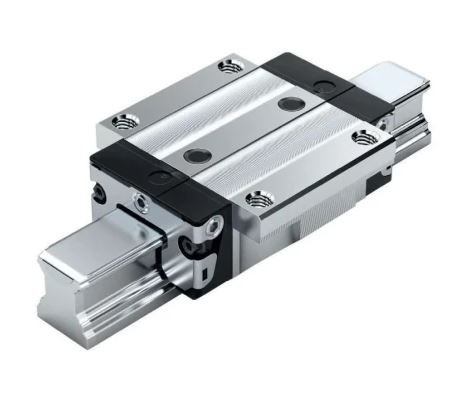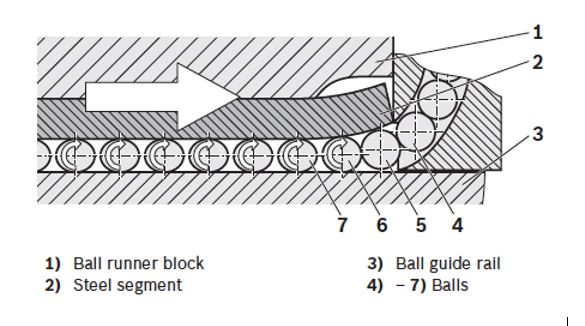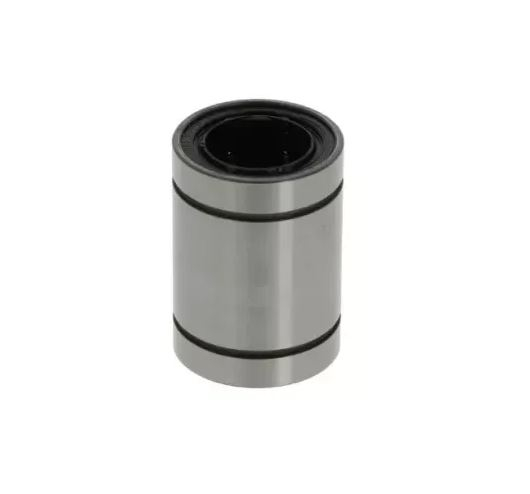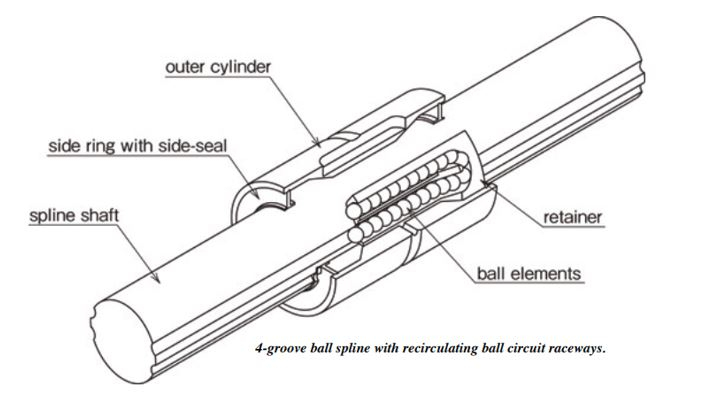Linear Bearing Basics

All bearings perform two jobs: they facilitate the motion of a load in one degree of freedom by reducing friction while at the same time restricting motion in all other degrees of freedom. For example, the shaft bearings carry the weight of your car and reduce friction allowing the wheels to easily rotate, but constrain those same wheels to a fixed position on the car’s frame.
The engineering challenge of bearings lies in designing a part that is strong enough to carry a large static (and sometimes dynamic) load in the non-moving degrees of freedom while also allowing easy motion in a single dimension.
Most broadly, bearings can be divided into those that allow rotation of a subassembly relative to a fixed frame, and those that allow motion of a subassembly along a straight line relative to a fixed frame – the latter classification of bearings are called linear bearings.
Linear bearings are used for a wide range of applications including:
Machine Tools: In lathes, milling machines, grinders, 3D printers, and other precision machine tools for guiding and positioning tool heads and workpieces.
Industrial Automation: In assembly lines, robotic arms, and automated machinery use linear bearings for precise and repeatable motion. In semiconductor manufacturing, for example, the fab lines use linear bearings for high positional precision and cleanliness.
Medical Equipment: Linear bearings are frequently used in medical imaging devices like MRI machines, X-ray systems, and in laboratory automation equipment to move patient couches into and out of the machine, or to move the equipment over and around the patient.
Material Handling and Logistics: Conveyor systems, sorting machines, and automated storage and retrieval systems rely heavily on linear bearings for long life and safe operation.
Stage and Entertainment Equipment: In theater and film sets linear bearings are utilized for moving props, cameras, and stage equipment.
| Find linear bearings in the e-shop | Online shop |
Types of Linear Bearings
In general, linear bearings employ a rail of some kind along which a mating assembly moves relative to the rail. The rail is usually straight but can be curved, and in any case between the rail and the moving assembly is mounted the linear bearing.
The linear bearing can be a plain bearing, made from a low-friction material that is in sliding contact with the rail or contain ball bearings that are in rolling contact with the rail.
The rail is commonly a rectangular profile part with grooves on the side to contain the bearing or a shaft of circular cross-section that receives a bushing bearing.
Linear Guide Rails
Linear guide rails are rectangular profile rails that are bolted to the stationary frame, and onto which “blocks” (or “carriages”) are installed.
The bearing blocks contain either balls or rollers that provide the rolling contact with the rail, reducing friction and allowing free motion along the rail while carrying the bearing load.

The rollers or balls in the block can be caged and would therefore are classified as non-recirculating bearings. These have somewhat higher friction since the rolling elements have to interact with the cage.
The other design for these linear bearings is called “recirculating.” By providing a path for the balls to circulate in a channel from the leading edge of the block back to the trailing edge and then return to the leading edge, an even lower friction bearing is possible since the balls are not constrained by a cage.
Recirculating linear bearings do have their challenges, however. Since the balls or rollers have to move between a loaded state and an unloaded state (when they are in the return zone), this transition causes a jitter that is often undesirable. Much development work has been done to reduce this jitter and increase the travel accuracy of the bearing.

When choosing a linear rail and bearing system, the size, preload, and accuracy are important criteria to consider.
Preload describes the clearance between the bearing block and the rail and affects the position accuracy of the bearing. Preload is a tradeoff between positional accuracy (due to deflection of the bearing under load) and friction/lifespan.
Deflection can be an issue when the bearing block carries a long tooling arm, for example, where small deflections at the block are exaggerated by the length of the tooling arm.
Linear rail and bearing blocks can be configured in one of three ways: a single block on a single rail, multiple blocks on a single rail, and multiple blocks on multiple rails. Accuracy in linear rail and bearing block assemblies can be measured in the following five ways:
1. height tolerance of the rail/block assembly;
2. height difference between multiple blocks on the same rail;
3. width tolerance of the rail/block assembly;
4. width differences between multiple blocks on the same rail;
5. parallelism between reference edges of the rail and the block – particularly important in multiple rail scenarios.
Linear Ball Bearing Bushings
The word “bushing” describes a sleeve installed on a shaft. Some bushings allow the rotation of a shaft, but there are also linear bushings that facilitate motion along the shaft. In this case, the shaft functions as the linear rail for the bushing that slides along the shaft.

However, unlike the linear rail system described above, the shaft/bushing combination can be reversed: the bearing bushings can be mounted to the stationary frame and the shaft can slide axially through the bushing. These linear bushings can be a plain bearing, made from a low-friction material that is in sliding contact with the shaft or contain recirculating ball bearings that are in rolling contact with the shaft. The bearing bushing is usually fitted into a block designed to accept the bushing.
To provide torque transfer while also enjoying a nearly frictionless motion along the axis of a shaft, a ball spline bearing can be used. This bearing design requires a shaft with between 2 and 6 grooves (splines) on the surface of the shaft cut in the axial dimension. A recirculating ball bushing fits on the shaft, and the balls ride in the splines.

The loading (both the radial load and the torque load) of the ball spline bearing determines how many splines should be used.
| Find linear bearings in the e-shop | Online shop |
Combined Bearings
Used extensively for forklift masts, combined roller bearings are heavy-duty, low-precision linear bearings that ride in a “C” profile channel to support axial loads and side loads simultaneously.
FAQ about Linear Bearings
What is the difference between linear and ball bearings?
While the term “ball bearing” is often assumed to mean a rotary bearing, both linear and rotary bearings can use rolling elements such as balls or rollers to carry loads and facilitate motion (either rotation or translation). A bearing without any rolling elements between the moving parts is called a “plain bearing” – and both linear and rotary bearings can be designed as a plain bearing. Plain bearings are often less expensive both to purchase and maintain but generate more friction than ball bearings.
What is the difference between a bushing and a linear bearing?
A bushing is a part that includes a bore to accept a shaft. Bushings can facilitate shaft rotation, but they can also be used to translate a subassembly axially along a shaft. These bushings are called “linear bushing bearings”. Bushing bearings can be plain bearings, or they can contain ball bearings for precise low-friction operation.
What is another name for a linear bearing?
Linear bearings support (or “bear”) a load while allowing translation on a linear or curved path. Other names for these parts include “linear slide”, “ball slide”, “roller slides”, or “linear bushing”.
| Find linear bearings in the e-shop | Online shop |



























Leave a Comment
Your email address will not be published. Required fields are marked *